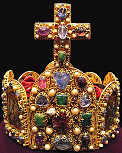Important personalities
24. 11. 2011
The first coronation of Karel IV, Roman king 26th of November 1346
Charles IV is undoubtedly one of the most important figures in Czech history. He was born on the 14th of May 1316 as the oldest son of John of Luxemburg and Elizabeth of Bohemia. Young Wenceslaus was sent to be educated at the French court and there he chose the name Charles at his Confirmation, a name which entered not only Czech history.
From the early forties Charles was the favorite papal curia, he was supported in his election as Roman ruler of by the then Pope Clement VI, Charles’ former teacher. In contrast, opponents of the papal hegemony concentrated around Ludwig of Bavaria, Charles’ adversary and Roman Emperor.
On the 11th of July 1346 not far from Rhens, Charles was elected as Roman king in opposition over Ludwig of Bavaria. He was not selected for the position randomly - on the hill above him was a royal throne made of stone. Charles was voted in by five of the seven electors: the Archbishop of Cologne, Archbishop of Mainz, Archbishop of Trier, the Saxon Duke Rudolf and the Czech King John, Charles’ father. Two other electors, the Margrave of Brandenburg and the County Palatine of the Rhine, refused to participate. Both of these electors supported Ludwig of Bavaria.
Charles was not crowed Roman King immediately, however. Charles and his father waited for the date in Trier while there was a turnaround in the French-English war. The coronation was postponed and John and Charles went to the aid of the French at the Battle of Crecy. John died in this battle, which meant that the wounded Charles became the King of Bohemia.
The coronation of the King of Rome finally took place on the 26th of November 1346. Ancient Aachen refused to recognize Karel as the new Holy Roman King so instead of the traditional Aachen or Cologne - cities that supported Ludwig of Bavaria and which refused to admit Charles through their gates - the event took place in Bonn. Charles was crowned with a replacement crown, since the true crown was in the possession of the House of Wittelsbach.
In 1347, Charles’ opponent Ludwig of Bavaria died suddenly while hunting. This, of course, did not end the struggle for the Holy Roman throne. It was continued by Ludwig of Brandenburg, who tried to promote the English King Edward III as king in opposition. Charles was re-elected and crowned in 1349. This time, the coronation took place with all the pomp of the ancient Aachen. Charles was seated on the throne of Charlemagne. The historic crown, which was still in possession of the House of Wittelsbach, was once again not used at the coronation. The crown that was placed on Charles’ head is still preserved in Aachen as it was installed on the reliquary bust of Charlemagne.
From the time of the second coronation, Charles was recognized as the one true Holy Roman monarch, yet he still had to wait to be named emperor. In 1355, after a journey to Rome lasting several months, he was proclaimed Roman Emperor by the Pope. In contrast to his coronation as king, the imperial crown of the Holy Roman Empire, probably originating from the year 962 when Ota the first was crowned, was used at his coronation as emperor, as well as other sacraments of the Holy Roman Empire, which Charles and his entourage received from the heirs of Ludwig of Bavaria.
Charles’ position as the Holy Roman King and later Emperor was important for Luxembourg and therefore for the Czech kingdom. From these important positions of power Charles IV was successful in influencing the position of the Bohemian Kingdom within the Holy Roman Empire and also tried.
Author of the text: Michaela Ducháčková







